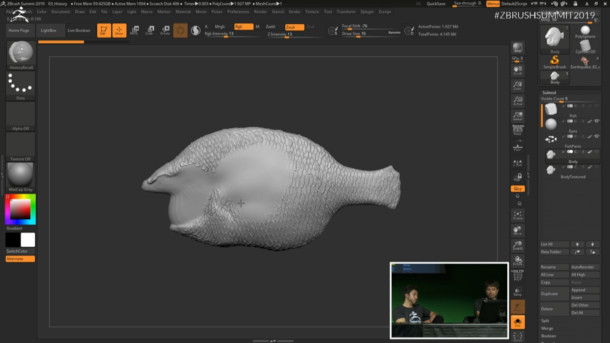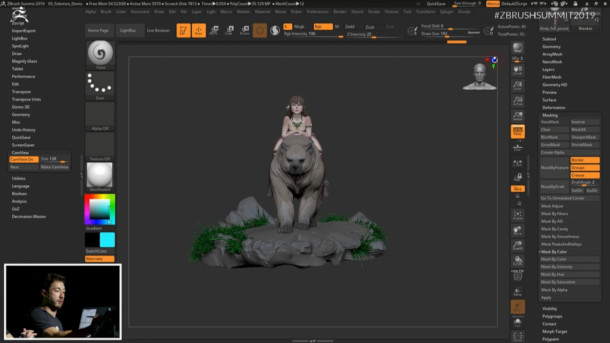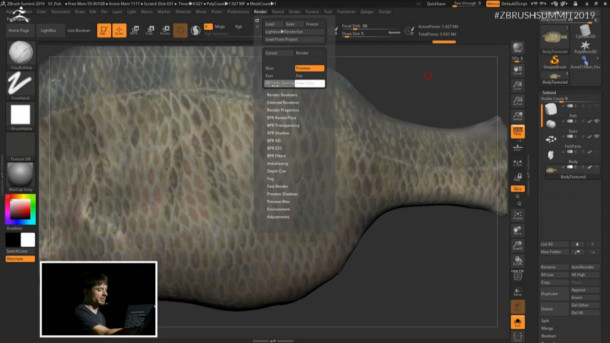See the new ZBrush features from ZBrush Summit 2019
Pixologic has unveiled some of the new features in development for ZBrush, its industry-standard digital sculpting software, at its ZBrush Summit 2019 user event.
Highlights included an innovative set of history-aware sculpting tools, a new draft analysis system for 3D fabrication, and the option to sculpt or paint on the UV unfolded surface of a model.
No definite release dates, but most of the features will probably be part of ZBrush 2020
Although Pixologic has announced new releases of ZBrush at ZBrush Summit in the past, this year’s demo was simply of new features in development.
While it’s possible that some will end up in ZBrush 2019.2 or a similarly named point update, if the company follows the same release pattern as it did at ZBrush Summit 2018, most will end up in ZBrush 2020.

The new XTractor brush in use to duplicate sculpted scales across the surface of a fish model.
Duplicate surface details with XTractor and XTractorDragRect
Features on show included an interesting new set of history-aware sculpting features that enable a user to make changes to a sculpt according to the differences between two states in the Undo history.
Of those, the XTractor and XTractorDragRect brushes are primarily intended for duplicating smaller details, like skin pores or scales, across a sculpt.
With them, an artist can sculpt details on a small part of a model, set points in the Undo history before and after they were applied, then select a region of the model’s surface.
ZBrush then generates an alpha for that region based on the change in its surface geometry between the two Undo states, which can then be used to paint the details across the rest of the model.
At ZBrush Summit, the workflow was used to convert a single scale sculpted on the surface of a fish into a complete set of scales across its body.
The brushes can also take RGB information from the selected region of a texture and convert it to an alpha that can be used for sculpting detail.

HistoryRecall can be used to revert parts of a model to an earlier state: here, removing scales from the fish.
Revert changes or conform clothing with HistoryRecall
The new HistoryRecall brush works in a similar way, but on a global scale.
With it, users can select the state of an entire model from the Undo timeline, then paint that state back over the current model.
As well as being useful for partially reverting changes made to a sculpt over time, the brush can be used more creatively: for example, to conform sculpted clothing to a character.
By storing the SubTool for the body as an Undo state, then painting that state onto the clothing at a low intensity, an artist can move the surface of the clothing inwards towards the character’s body.
According to ZBrush, it’s even possible to use the workflow to project a model from another scene onto the one on which you are currently working.

Draw Draft Analysis colour codes parts of a model that will cause problems during injection moulding.
New Draw Draft Analysis display option for 3D fabrication
Artists working on models that will be fabricated physically get a new Draw Draft Analysis option.
As with draft analysis systems in CAD software, it is designed to identify and troubleshoot parts of a model that will cause problems during injection moulding.
In order for the cast to pull away cleanly from the mould, its sides must be angled slightly, not parallel to the pull direction, or undercutting it.
When a user clicks the new Draw Draft Analysis button in the Transform palette, then sets a target angle, ZBrush displays those parts of the model that will separate correctly in green.
Parts parallel to the pull direction are shown in yellow, and undercuts are shown in red.
The display updates in real time, so an artist can continue sculpting or make parametric changes to the model until all of the problem areas are resolved.

Users can edit the colours of a Polypainted sculpt from the Adjust Color preview window.
New tools for adjusting colours of Polypainted sculpts
New painting features include Adjust Color, which makes it possible to make quick global changes to the Polypaint colour scheme of a sculpt during look development.
Accessed via a new Polypaint Color Utilities palette, Adjust Color pops up a preview window from which the hue, saturation or contrast of a selected colour can be adjusted.
A Mask by Color option makes it possible to create soft transitions between colours.

Morph UV unfolds a model, making it possible to work directly on a flat, undistorted surface. Here, a single continuous seam is being sculpted up the inside of the arm and sides of the jacket shown in the image inset.
Morph UV lets you paint or sculpt directly on unfolded models
Another handy new feature that can be used either for painting or sculpting is Morph UV.
It unfolds the SubTool selected, making it possible to work directly on a flattened surface, avoiding distortion when projecting a texture onto the model using SpotLight.
Other suggested use cases include making long strokes across the surface of complex models: for example, when sculpting seams on clothing.
Rather than an artist having to sculpt part of the seam, readjust the camera view, then sculpt the next part, Morph UV makes it possible to work in a single smooth continuous stroke.

The CamView widget at the top right of the viewport can be used to switch between orthographic views.
CamView: ZBrush’s answer to Autodesk’s ViewCube
Other features in development include CamView, which works like the ViewCube in Autodesk software.
When activated from the Preferences menu, it displays a 3D widget in the top right corner of the viewport that can be used to rotate a model, or toggle between top, bottom, left and right views.
As well as adjusting the size of the widget, users can completely change its appearance: a Make CamView option replaces the default model used for the widget with one of the user’s choosing.

The new Fade Opacity slider adjusts the opacity of a texture being applied to a model.
Smaller workflow features plus a new Z Zoo library of readymade creature armatures
Smaller changes shown during the presentation included the option to change the opacity of a reference texture being applied to a model to make it easier to see surface details while sculpting.
It will also be possible to choose whether the alpha selected clips a texture being painted onto the surface of a model – the current default behaviour in ZBrush – or not.
Pixologic is also working on Z Zoo, a Lightbox library of readymade ZSphere armatures that can be used as the basis for sculpts of an entire menagerie of real-world animals.
The assets are being created in collaboration with artists including 3D Character Workshop’s Shane Olson.

The full list of features currently in development for ZBrush, including some not shown at ZBrush Summit.
Other features: Peel UV is still in development
And although it wasn’t shown during the presentation, Pixologic’s summary slide of ZBrush features currently in development confirms that the firm is still working on Peel UV.
The UV plugin – an alternative to UV Master that enables users to place UV seams precisely – was shown at ZBrush Summit last year, but didn’t make it into either ZBrush 2019 or ZBrush 2019.1.
Other features listed on Pixologic’s summary slide but not shown during the presentation include Polypaint from Draft, Polypaint from Thickness, and a new Curve Deco Brush.
Pricing and availability
Pixologic hasn’t confirmed which version of ZBrush the new features will be part of, or announced pricing or a release date for the next update.
The current version of ZBrush, ZBrush 2019.1.2, is available for 64-bit Windows Vista and above and Mac OS X 10.10 and above. A new licence costs $895.
Read more about ZBrush on Pixologic’s website
(No information about the upcoming features at time of posting)
